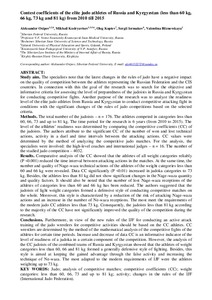Показать сокращенную информацию
Contest coefficients of the elite judo athletes of Russia and Kyrgyzstan (less than 60 kg, 66 kg, 73 kg and 81 kg) from 2010 till 2015
| Автор | Осипов, А. Ю. | |
| Автор | Kudryavtsev, Mikhail | |
| Автор | Koptev, Oleg | |
| Автор | Iermakov, Sergii | |
| Автор | Bliznevskaya, Valentina | |
| Дата внесения | 2019-07-01T07:30:34Z | |
| Дата, когда ресурс стал доступен | 2019-07-01T07:30:34Z | |
| Дата публикации | 2018-06 | |
| Библиографическое описание | Осипов, А. Ю. Contest coefficients of the elite judo athletes of Russia and Kyrgyzstan (less than 60 kg, 66 kg, 73 kg and 81 kg) from 2010 till 2015 [Текст] / А. Ю. Осипов, Mikhail Kudryavtsev, Oleg Koptev, Sergii Iermakov, Valentina Bliznevskaya // International Journal of Applied Exercise Physiology. — 2018. — Т. 7 (№ 2). — С. 32-45 | |
| URI (для ссылок/цитирований) | http://www.ijaep.com/index.php/IJAE/article/view/267/136 | |
| URI (для ссылок/цитирований) | https://elib.sfu-kras.ru/handle/2311/111583 | |
| Аннотация | Study aim. The specialists note that the latest changes in the rules of judo have a negative impact on the quality of competition between the athletes representing the Russian Federation and the CIS countries. In connection with this the goal of the research was to search for the objective and informative criteria for assessing the level of preparedness of the judoists in Russia and Kyrgyzstan for conducting competitive fights. Another purpose of the research was to analyze the readiness level of the elite judo athletes from Russia and Kyrgyzstan to conduct competitive attacking fight in conditions with thesignificant changes ofthe rules of judo competitions based on the selected criteria. Methods. The total number ofthe judoists –n = 176. The athletes competed in categories less than 60, 66, 73 and up to 81 kg. The time period for the research is 6 years (from 2010 to 2015). The level of the athletes’ readiness was determined by comparing the competitive coefficients (CC) of the judoists. The authors attribute to the significant CC ofthe number of won and lost technical actions, activity in a duel and time intervals between the attacking actions. CC values were determined by the method of analyzing the competitive judo matches. For the analysis, the specialists were involved: the high-level coaches and international judges–n = 16. The number of the studied judo competition –4032. Results. Comparative analysis of the CC showed that the athletes of all weight categories reliably (P <0.001) reduced the time interval between attacking actions in the matches. At the same time, the number and quality of Nage-waza technical actions of theathletes of the weight categories less than 60 and 66 kg were revealed. Data CC significantly (P <0.01) increased in judoka categories to 73 kg. Besides, the athletes less than 81 kg did not show significant changes in the Nage-waza quantity and quality factors. It should also be noted that the number of lost Nage-waza receptions of theathletes of categories less than 60 and 66 kg has been reduced. The authors suggested that the judoists of light weight categories formed a defensive style of conducting competitive matcheson the whole. Moreover, this style is characterized by a reduction ofthe risk of attacking Nage-waza actions and an increase in the number of Ne-waza receptions. The most meet the requirements of the modern judo CC athletes less than73 kg. Consequently, the judoists less than 81 kg according to the majority of the CC havenot significantly improvedthe quality of the competition during the research. Conclusions. Furthermore, in view of the new rules of the IJF for conducting an active attack training of the judo wrestlers for competitiveactivities should be based on the CC athletes. CC wrestlers are determined by the method of the mathematical analysis of the competitive fights of the athletes for certain time periods. Increase and decrease of data CC is an informative indicator of the level of readiness of a judoka in a certain component of the competition. However, the analysis of the CC judoists of the combined teams of Russia and Kyrgyzstan showed that the athletes of weight categories less than 60, 66 and 81 kg formed a generally defensive style of fighting. Besides, this style is aimed at keeping the gained advantage through the false activity and increasing the technique of Ne-waza. The most adapted to the modern requirements of IJF were the athletes weighing up to 73 kg. | |
| Тема | Judo | |
| Тема | analysis of competitive matches | |
| Тема | competitive coefficients (CC) | |
| Тема | weight categories: less than60 | |
| Тема | 66 | |
| Тема | 73 and up to 81 kg | |
| Тема | activity | |
| Тема | changes in the rules of the IJF (International Judo Federation) | |
| Название | Contest coefficients of the elite judo athletes of Russia and Kyrgyzstan (less than 60 kg, 66 kg, 73 kg and 81 kg) from 2010 till 2015 | |
| Тип | Journal Article | |
| Тип | Journal Article Preprint | |
| Страницы | 32-45 | |
| ГРНТИ | 77.03.31 | |
| Дата обновления | 2019-07-01T07:30:34Z | |
| DOI | 10.22631/ijaep.v7i2.267 | |
| Институт | Институт физической культуры, спорта и туризма | |
| Подразделение | Кафедра физической культуры | |
| Подразделение | Кафедра валеологии | |
| Журнал | International Journal of Applied Exercise Physiology | |
| Квартиль журнала в Web of Science | без квартиля |

